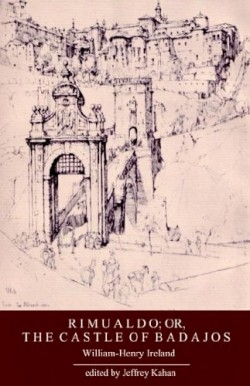
Rimualdo
or, the Castle of Badajos
Depending on one’s frame of reference, the term “Gothic novel” conjures images of beautiful young women in trailing diaphanous vestments, treading winding cobweb-ridden staircases in mouldering old mansions, armed only with flickering lights … or calls to mind instead the hysteria-inducing reading matter so often favored by proper young ladies and the working class in England’s Regency period. The genre actually began in 1764 with Walpole’s The Castle of Otranto; this book first saw publication in 1800.
Rimualdo himself, the Condè del Lara, is an engaging young nobleman off to the Spanish court for the first time after a sequestered upbringing by his noble parents, the Marques and Marquesa. His journey to Toledo to wait upon the King might have ended in tragedy, were it not for the intervention of a mysterious youth named Cesario, recently widowed and taken utterly into the Condè’s favor. Cesario arrives at Rimualdo’s lodging just in time to rescue the young Condè from the blade of a brigand. Thus begins a grand, spooky, and marvelously device-ridden adventure that aficionados of the historical genre will love.
The editor completed his Ph.D. on the author’s “Shakespeare Papers” at the Shakespeare Institute, University of Birmingham. He has previously written and edited several works by and about Ireland. Here, his extensive notes and introduction provide historical perspective and insights into Ireland’s work and personality, as well as a glimpse at the period during which he wrote. Ireland, says Kahan, wrote many works, including plays, that he attributed to others—including a “Shakespearean” play called Vortigern. Rimualdo was published under Ireland’s own name, however, and, says Kahan, draws on the author’s own experience with illegitimacy, honor, nobility, and religion, as well as showing the deep bonds that can develop between two male friends.
In flowery language suited to the period, the two faithful friends encounter every now-clichéd device of the Gothic: innocent heroines, betrayals, wicked noblemen, an evil monk, gruesome apparitions (“… a countenance meager, bloodless, and o’erspread with a livid hue, met his terrified gaze! The locks that hung on either shoulder were dripping with crimson gore; a purple stream, as if just gushing from a fresh-inflicted wound, fast trickled o’er her fleshless hands, besmearing the pale robe that covered her bosom, and her deadened eyes, deep sunk within their sockets, were turned full upon the crucifix“), plus thwarted lovers, murder, dungeon imprisonments, and haunted chambers with secret rooms.
As Rimualdo and Cesario seek the freedom of Rimualdo’s beloved, Constanza, and the truth about Cesario’s mysterious origins, they must deal with the threat of Rimualdo’s noble father to disown him, and with the far more dangerous interventions of the Marques di Badajos—a man of sinister aspect who seems to have held Rimualdo in antipathy at first sight.
One of the most compelling scenes depicts Cesario, who, imprisoned by the Marques, suffers from the cold and damp in the dungeon. There, behind a loose stone, he finds a journal wrapped in a bloodstained scarf. He reads, to his horror, the story of the Marques’s late wife and her brother, both murdered by him—the former by the blade, the latter by starvation in that very dungeon, accompanied by his sister’s bloody corpse—and despairs of his own fate. In a marvelous twist, however, Ireland weaves together an earlier, if improbable, thread to win Cesario’s freedom at the hands of a brigand, so that he can ride forth to assist Rimualdo in his quest to save Constanza.
Zittaw Press, which brought this delight out of the shadows for modern readers, devotes itself to the Gothic in its various forms, offering re-publications of both canonical (novels: examples include, according to the publisher, The Castle of Otranto, The Monk, and Frankenstein) and trade Gothics (these were chapbooks or bluebooks, sold for a shilling, that enjoyed a busy street trade during the height of the Gothic’s popularity). Using utterly wonderful cover illustrations and reclaiming these often obscure gems whose echoes can still be heard in the writings of modern authors “from Joyce Carol Oates to Anne Rice,” Zittaw produces the shorter “trade” chapbooks in editions printed on cotton rag paper with handsewn bindings, and the longer works—such as this one—in trade paperbacks.
Readers seeking insights into the period, the genre, and Ireland himself will find not only Kahan’s informative introduction but also a bibliography and substantial notes to guide them. Those interested simply in the tale itself and its convoluted plot will find a pleasant journey ahead, full of twists and turns that smack of deus ex machina but are thoroughly entertaining nonetheless.
Disclosure: This article is not an endorsement, but a review. The publisher of this book provided free copies of the book to have their book reviewed by a professional reviewer. No fee was paid by the publisher for this review. Foreword Reviews only recommends books that we love. Foreword Magazine, Inc. is disclosing this in accordance with the Federal Trade Commission’s 16 CFR, Part 255.
